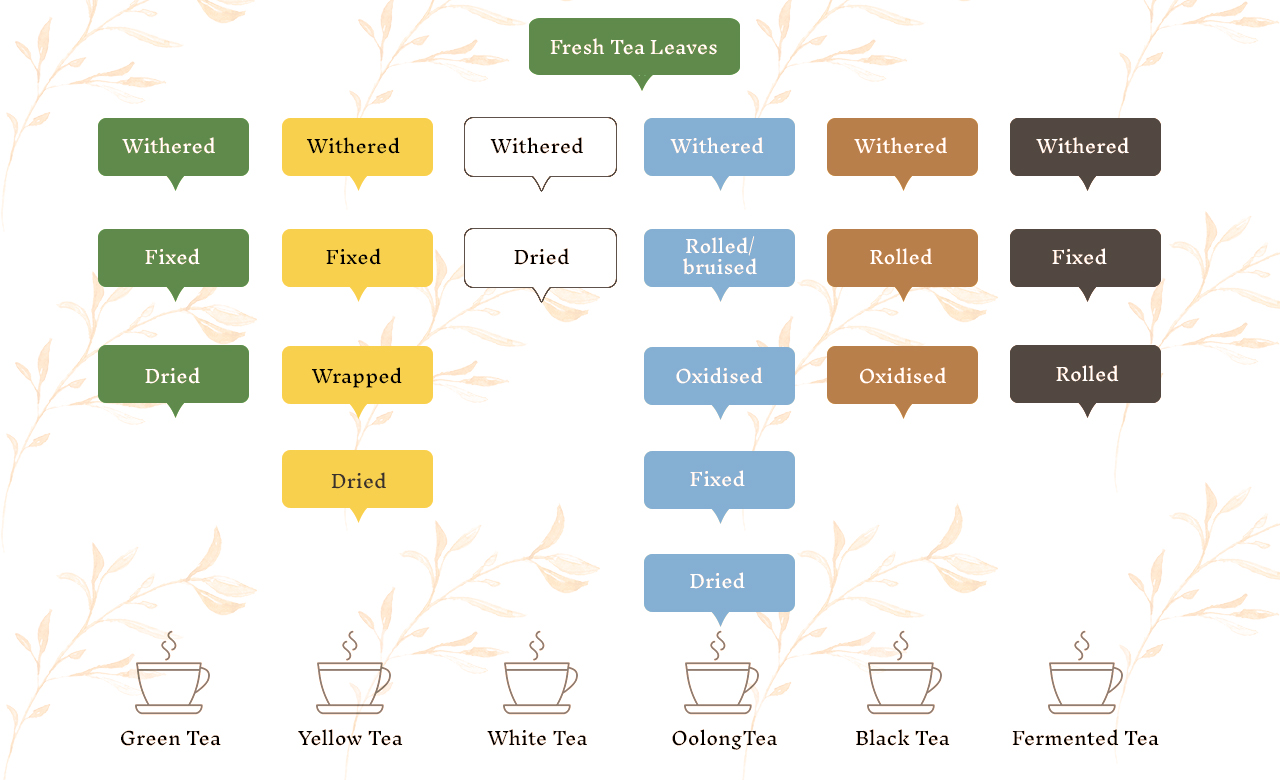You know that your favourite black tea originates in the tea gardens of Darjeeling or Assam and that green tea is the most popular in Japan and parts of China. But what gives the former a distinct, bold taste and the latter, a range of tastes from sweet to vegetal to fruity?
We explore the careful methods of tea processing before they enter into our world as diverse, flavourful and fantastic gourmet teas.
Same plant, different taste
While all the teas come from the same plant, camellia sinensis , every tea is different in appearance, taste and aroma. An interesting fact to know is that tea from the same tea garden may taste very different every year. It is because every tea harvest depends on the climate change, rainfall and soil conditions. Tea blenders work very hard to ensure your favourite tea keeps smelling and tasting the same year after year.
Classification of teas

Teas are mostly categorised into black, oolong, green, white, yellow, fermented and tisanes. The categorisation takes place on the basis of how much a tea is oxidised or exposed to oxygen. Interestingly, oxidisation begins as soon as the tea leaves are plucked from the plant. And then the following process of drying, withering, rolling and heating decides whether the tea will be white, green, black or yellow.
Let’s see how these teas are different from one another:
Black Tea
Have you wondered why you reach for your morning cup of kadak masala chai, or Darjeeling tea or Assam tea liquor? It is because of the high caffeine content of the black tea. Black teas are fully oxidised teas, and the results are dark brown or black leaf with robust flavours and darkish liquor. After being plucked, the leaves are allowed to wither and oxidise which makes their leaves turn black. Black teas are generally brewed at boiling point to release the caffeine.
Oolong Tea
Only a tea lover would know that oolong is not black tea, but somewhere between green and black. The traditional Chinese tea is semi-oxidised which gives it a complexity of a black tea and the freshness of a green tea. Oolong teas evoke flavour and aroma of fresh flowers or fruits.
Green Tea
Big fan of Green tea and can’t stop singing its merits? Well, you have every reason to. Green tea leaves are plucked in the morning and can be brewed the same evening. This means green tea leaves don’t undergo the oxidisation process as other tea leaves and have very low caffeine content. And that is also why the leaves retain their natural dark green colour, tannins, Vitamin C and other minerals. Now, you know why Green tea refreshes and soothes without causing insomnia.
White Tea
White teas are the least processed of all teas and have the least amount of caffeine too. Young tea buds are plucked when they are still enclosed in new leaves and this helps in retaining the silky downy quality of the tea. White tea has the most delicate flavour and aroma owing to the fact that these leaves are not rolled or crushed.
Yellow Tea
Not very popular; yellow tea has an appearance and flavour similar to green tea without its grassiness and astringency. Yellow teas are more oxidised than green teas and have a slower drying period in which the leaves are wrapped in special cloth. Yellow tea has a sweet, clean, bright floral taste.
Tisane
Tisanes are not true teas as they do not come from the camellia sinensis plant, but they guarantee a host of health benefits. These beverages come with the goodness of dried herbs, spices and fruits and are 100% caffeine-free. You can consume tisanes at anytime of the day. Popular tisanes include herbs such as mint, lemongrass, rooibos, flowers such as chamomile, jasmine and hibiscus, roots like chicory and ginger, fruits like apples and berries, and some even have nuts and cocoa.
Pu-Erh Tea
Darker than black tea, Pu-Erh tea is a naturally fermented tea. Large tea leaves are aged for several years. The more the tea is aged, the better is the flavour. Many good Pu-Erh teas will have a light film of mould as the leaves are exposed to fungal microflora and beneficial bacteria during the ageing process. Don’t be put off; many popular kinds of cheese also undergo the same process. Mature Pu-Erh tea is surprisingly mellow and has a sweet taste.
After reading this post, we are confident you know your teas better now.


